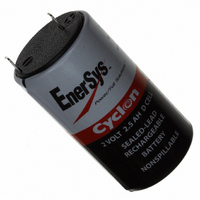0810-0004 EnerSys, 0810-0004 Datasheet - Page 8

0810-0004
Manufacturer Part Number
0810-0004
Description
BATT CYCLON SLA 2V 2.5AH
Manufacturer
EnerSys
Series
Cyclon®r
Type
Sealed Lead Acid Batteriesr
Specifications of 0810-0004
Voltage - Rated
2V
Capacity
2.5Ah
Size / Dimension
1.35" Dia x 2.41" H (34.3mm x 61.2mm)
Termination Style
Spade, .187" (4.7mm)
Rechargeability
Yes
Weight
0.39 lbs (176.90g)
Output Voltage
2 V
Chemistry
Lead Acid
Rechargeable/non-rechargeable
Rechargeable
Battery Capacity
25 Ah
Lead Free Status / RoHS Status
Lead free by exemption / RoHS compliant by exemption
Other names
842-1000
8
Higher currents than those shown in the table may be
maintained for durations shorter than one minute. The
ability of the cell or monobloc to maintain higher currents
is dependent on the magnitude of the current, its duration,
the frequency of its application and, most importantly, on
the ability of the terminal connection to act as a heat sink
and dissipate the heat generated. For high rate applications
we strongly recommend testing under actual or simulated
application conditions.
Table 3-1
3.3 Low Temperature Operation
Exceptional low temperature characteristics are maintained
through the use of a separator system that minimizes
resistance and diffusion effects. This feature, combined with
a large plate surface area, results in efficient utilization of
active materials and excellent voltage regulation.
Because the cell operates as a "starved" electrolyte
system, there is only enough electrolyte to maintain
the rated capacity of the cell. The capacity available at
low temperatures is a function of both temperature and
discharge current.
Figure 3-1 shows another reason why CYCLON
cells have good discharge performance at low temperatures.
Figure 3-1: Internal Resistance Vs. Temperature
www.enersys.com
CYCLON
D single cell (2.5Ah)
Tall D single cell (4.5Ah)
D monobloc (2.5Ah)
X single cell (5.0Ah)
E single cell (8.0Ah)
X monobloc (5.0Ah)
E monobloc (8.0Ah)
J single cell (12.0Ah)
BC single cell (25.0Ah)
500
400
300
200
100
0
-4
®
Battery Type
-30
-20
-10
Temperature, ºC
0
Max. amps to 1.50 VPC
10
20
100
250
65
65
50
65
65
50
50
®
battery
30
40
As the temperature drops, the increase in internal resistance
is relatively gradual down to a little under 0°C (32°F). This
also explains why CYCLON battery cells have excellent low
temperature performance.
3.4 Position Flexibility
With the starved electrolyte system, the sulfuric acid
is absorbed within the cell plates and the glass mat
separator. The cell is virtually dry with no free electrolyte,
allowing it to be charged, discharged or stored in any
position without electrolyte leakage.
3.5 Recombinant VRLA Design
One of the most important features of the CYCLON battery
design is its recombinant valve regulated lead-acid
(VRLA) design. This mode of operation is possible because
the cell is able to use the oxygen cycle during overcharge.
The oxygen, evolved at the positive electrode when the cell
is overcharged, is recombined at the negative electrode. A
self-resealing valve is provided as a safety vent in case of
misapplication or other abuse of the cell that would cause
the internal cell pressure to increase.
In CYCLON batteries, water loss is greatly reduced due
to two design features. First, because water tends to
decompose around impurities in the lead, the rate of
such decomposition is reduced due to the high purity of
the lead used in CYCLON batteries. Second, the use of
high pressure seals contains the gases within the cell,
promoting more efficient recombination.
In a conventional lead-acid cell, the charge current
electrolyzes the water to produce hydrogen from the
negative electrode and oxygen from the positive electrode.
Thus water is lost from the cell, and it must be replenished
by means of frequent topping up with water.
The evolution of the two gases does not occur at the same
time due to the fact that the recharge efficiency of the
positive electrode is less than that of the negative electrode.
This means that oxygen is evolved from the positive plate
before the negative plate can generate hydrogen.
As oxygen is evolved from the positive plate, a significant
quantity of highly active spongy lead exists on the negative
electrode before the negative plate can generate hydrogen.
If the oxygen that is generated by the positive plate can be
transported to the negative plate, the spongy lead will react
rapidly with the oxygen to form lead oxide as shown by the
following reaction:
2Pb + O
2
➔ 2PbO (Eqn. 1)
Publication No: US-CYC-AM-007 - April 2008















